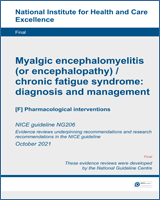From: Pharmacological interventions

NCBI Bookshelf. A service of the National Library of Medicine, National Institutes of Health.
| Outcomes | No of Participants (studies*) Follow up | Quality of the evidence (GRADE) | Relative effect (95% CI) | Anticipated absolute effects | |
|---|---|---|---|---|---|
| Risk with Control | Risk difference with Antidepressants (fluoxetine) versus antipsychotics (amisulpride) (other) (95% CI) | ||||
|
Quality of Life: SF12 Scale from: 0 to 100. |
40 (1 study) 12 weeks |
⊕⊝⊝⊝ due to risk of bias, indirectness |
The mean quality of life: sf12 at 12 weeks in the control groups was 53.2 |
The mean quality of life: sf12 at 12 weeks in the intervention group was 15.6 lower (18.61 to 12.59 lower) | |
|
Fatigue: Fatigue Severity Scale Scale from: 9 to 63. |
40 (1 study) 12 weeks |
⊕⊝⊝⊝ due to risk of bias, indirectness |
The mean fatigue: fatigue severity scale at 12 weeks in the control groups was 36.3 |
The mean fatigue: fatigue severity scale at 12 weeks in the intervention group was 12.6 higher (8.26 to 16.94 higher) | |
|
Psychological status: HADS anxiety Scale from: 0 to 21. |
40 (1 study) 12 weeks |
⊕⊝⊝⊝ due to risk of bias, indirectness, imprecision |
The mean psychological status: hads anxiety at 12 weeks in the control groups was 4.5 |
The mean psychological status: hads anxiety at 12 weeks in the intervention group was 0.4 higher (0.22 lower to 1.02 higher) | |
|
Psychological status: HADS depression Scale from: 0 to 21. |
40 (1 study) 12 weeks |
⊕⊝⊝⊝ due to risk of bias, indirectness, imprecision |
The mean psychological status: hads depression at 12 weeks in the control groups was 4.3 |
The mean psychological status: hads depression at 12 weeks in the intervention group was 0.1 lower (0.69 lower to 0.49 higher) | |
|
Pain: pain on VAS Scale from: 0 to 100. |
40 (1 study) 12 weeks |
⊕⊝⊝⊝ due to risk of bias, indirectness |
The mean pain: pain on vas at 12 weeks in the control groups was 40.5 |
The mean pain: pain on vas at 12 weeks in the intervention group was 12.6 higher (5.8 to 19.4 to higher) | |
|
Adverse events: FIBSER global burden Scale from: not reported. |
40 (1 study) 12 weeks |
⊕⊝⊝⊝ due to risk of bias, indirectness, imprecision |
The mean adverse events: fibser global burden at 12 weeks in the control groups was 0.8 |
The mean adverse events: fibser global burden at 12 weeks in the intervention group was 0.2 lower (0.67 lower to 0.27 higher) | |
|
Symptom scales: Clinical Global Impression Severity (CGI-S) Scale from: 1 to 7. |
40 (1 study) 12 weeks |
⊕⊝⊝⊝ due to risk of bias, indirectness |
The mean symptom scales: clinical global impression severity (cgi-s) at 12 weeks in the control groups was 2.9 |
The mean symptom scales: clinical global impression severity (cgi-s) at 12 weeks in the intervention group was 1.3 higher (0.75 to 1.85 higher) | |
Downgraded by 1 increment if the majority of the evidence was at high risk of bias, and downgraded by 2 increments if the majority of the evidence was at very high risk of bias
The majority of the evidence included an indirect population (downgraded by one increment): downgraded if the ME/CFS diagnostic criteria used did not include PEM as a compulsory feature [original analysis]; percentage of participants with PEM unclear [PEM reanalysis – see Appendix G for additional details]
Downgraded by 1 increment if the confidence interval crossed one MID or by 2 increments if the confidence interval crossed both MIDs
Studies included: Pardini 2011
From: Pharmacological interventions

NCBI Bookshelf. A service of the National Library of Medicine, National Institutes of Health.